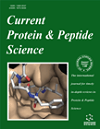- Home
- A-Z Publications
- Current Protein and Peptide Science
- Previous Issues
- Volume 25, Issue 8, 2024
Current Protein and Peptide Science - Volume 25, Issue 8, 2024
Volume 25, Issue 8, 2024
-
-
Recent Advancement in Novel Wound Healing Therapies by Using Antimicrobial Peptides Derived from Humans and Amphibians
More LessThe skin is the biggest organ in the human body. It is the first line of protection against invading pathogens and the starting point for the immune system. The focus of this review is on the use of amphibian-derived peptides and antimicrobial peptides (AMPs) in the treatment of wound healing. When skin is injured, a chain reaction begins that includes inflammation, the formation of new tissue, and remodelling of existing tissue t Read More
-
-
-
Comprehensive Overview of Treponema pallidum Outer Membrane Proteins
More LessAuthors: Sirui Wu, Lan Luo, Fei Ye, Yuanfang Wang and Dongdong LiTreponema pallidum, the causative agent of syphilis, is a sexually transmitted microorganism that exhibits remarkable motility capabilities, allowing it to affect various systems. Despite its structural resemblance to gram-negative bacteria due to its dual-membrane, T. pallidum possesses a lower abundance of outer membrane proteins (OMPs), which enables it to effectively conceal itself. This review presents a comprehensive ana Read More
-
-
-
Dominant Circulating Cell-free Mycobacterial Proteins in In-use Machining Fluid and their Antigenicity Potential
More LessAuthors: Harish Chandra, Bethany Ahlers, Ying Wai Lam and Jagjit S. YadavBackground: Occupational exposure to industrial Metalworking Fluid (MWF) colonized by Mycobacterium immunogenum (MI) has been associated with immune lung disease hypersensitivity pneumonitis (HP) in machinists. This warrants regular fluid monitoring for early detection of mycobacterial proteins, especially those with antigenic potential. Objective: To detect and identify dominant MI proteins and antigens dir Read More
-
-
-
Carboxylic Group Functionalized Carbon Quantum Dots inhibit Hen Egg White Lysozyme Amyloidogenesis, leading to the Formation of Spherical Aggregates with Reduced Toxicity and ROS Generation
More LessAuthors: M.P. Taraka Prabhu, Shreya Chrungoo and Nandini SarkarIntroduction: Proteinopathies are a group of diseases where the protein structure has been altered. These alterations are linked to the production of amyloids, which are persistent, organized clumps of protein molecules through inter-molecular interactions. Several disorders, including Alzheimer's and Parkinson's, have been related to the presence of amyloids. Highly ordered beta sheets or beta folds are characteristic Read More
-
-
-
Structural Insights of PD-1/PD-L1 Axis: An In silico Approach
More LessAuthors: Shishir Rohit, Mehul Patel, Yogesh Jagtap, Umang Shah, Ashish Patel, Swayamprakash Patel and Nilay SolankiBackground: Interaction of PD-1 protein (present on immune T-cell) with its ligand PD-L1 (over-expressed on cancerous cell) makes the cancerous cell survive and thrive. The association of PD-1/PD-L1 represents a classical protein-protein interaction (PPI), where receptor and ligand binding through a large flat surface. Blocking the PD-1/PDL-1 complex formation can restore the normal immune mechanism, thereby destroyin Read More
-
-
-
Influences of Ipomoea batatas Anti-Cancer Peptide on Tomato Defense Genes
More LessAuthors: Hsin-Hung Lin, Kuan-Hung Lin, Yung-Lin Tsai, Rong-Jane Chen, Yen-Chang Lin and Yu-Chi ChenAims: This study investigates the impact of IbACP (Ipomoea batatas anti-cancer peptide) on defense-related gene expression in tomato leaves, focusing on its role in plant defense mechanisms. Background: Previously, IbACP was isolated from sweet potato leaves, and it was identified as a peptide capable of inducing an alkalinization response in tomato suspension culture media. Additionally, IbACP was found to regulate the Read More
-
Volumes & issues
-
Volume 26 (2025)
-
Volume 25 (2024)
-
Volume 24 (2023)
-
Volume 23 (2022)
-
Volume 22 (2021)
-
Volume 21 (2020)
-
Volume 20 (2019)
-
Volume 19 (2018)
-
Volume 18 (2017)
-
Volume 17 (2016)
-
Volume 16 (2015)
-
Volume 15 (2014)
-
Volume 14 (2013)
-
Volume 13 (2012)
-
Volume 12 (2011)
-
Volume 11 (2010)
-
Volume 10 (2009)
-
Volume 9 (2008)
-
Volume 8 (2007)
-
Volume 7 (2006)
-
Volume 6 (2005)
-
Volume 5 (2004)
-
Volume 4 (2003)
-
Volume 3 (2002)
-
Volume 2 (2001)
-
Volume 1 (2000)
Most Read This Month
Article
content/journals/cpps
Journal
10
5
false
en


